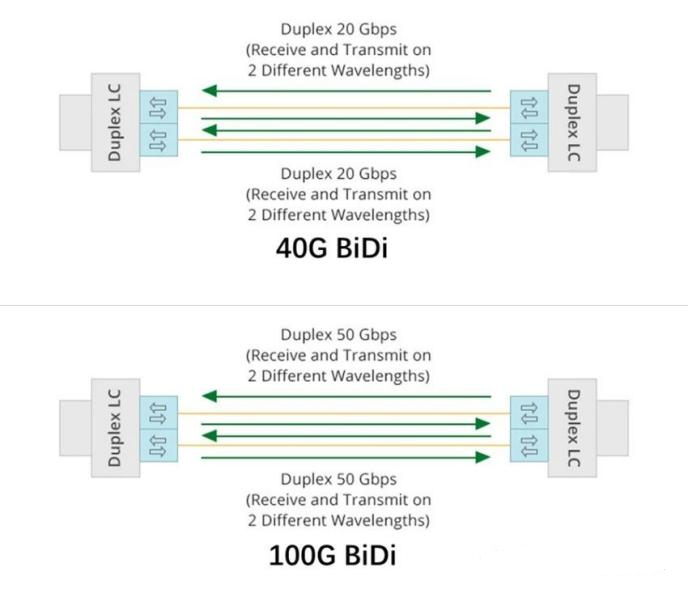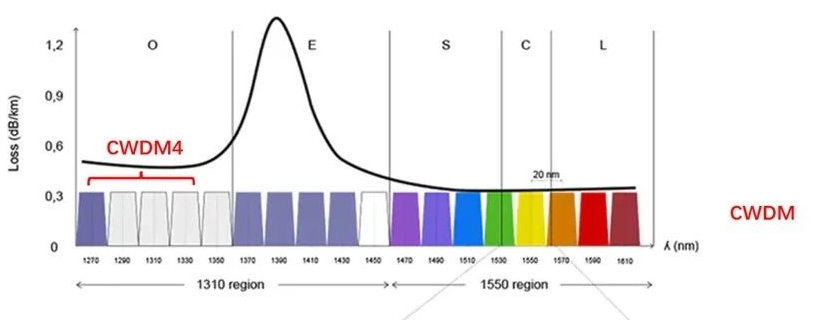AI big models, HPC, big data, cloud computing and other businesses develop rapidly, which drives the rapid growth of computing infrastructure, and the increasing demand for high-speed and high-efficiency data transmission.
There are three ways to increase the rate of optical transceiver:
- Higher-order modulation technologies, such as NRZ → PAM4 → xQAM
- Increase the speed of optical devices (higher baud rate), such as from 25G → 50G → 100G → 200G
- Increase the number of parallel channels (more lanes): Increase the number of fiber pairs, such as SR4 with 4 pairs of multimode fiber, transmitting 100G (25G per channel); Using wavelength division multiplexing, such as LR4 with a pair of single mode fibers, transmitting 100G (25G per wavelength), or 40G BiDi, transmitting 40G (single-fiber bidirectional, 20G per wavelength)
Let’s focus on the idea of wavelength division multiplexing.
What is wavelength division multiplexing?
Wavelength Division Multiplexing (WDM) is a technology used in optical fiber communications to increase data transmission capacity and speed. It divides optical signals into multiple wavelengths, each of which carries an independent signal, thereby achieving the transmission of multiple signals without interfering with each other.
Common WDM classification
There are two common WDM transmission modes, namely dual-fiber unidirectional and single-fiber bidirectional.
- Single-fiber bidirectional refers to an optical channel that transmits in two different directions on a single optical fiber at the same time. The wavelengths used are separated from each other, and each wavelength transmits data in one direction to achieve full-duplex communication between the both sides.
- Dual-fiber unidirectional means that all optical paths are transmitted in the same direction on one optical fiber at the same time. Different wavelengths carry different optical signals, which are combined at the sending end and transmitted through one optical fiber. At the receiving end, they are demultiplexed to complete the transmission of multiple optical signals. The reverse direction is transmitted through another optical fiber. The transmission in the two directions is completed by two optical fibers respectively.
There are different wavelength division multiplexing technologies in multimode fiber and single mode fiber environments
In the case of multimode fiber, short-distance wavelength division multiplexing (SWDM) is often used; In the case of single mode, long-distance wavelength division multiplexing is first choice. Long-distance wavelength division multiplexing technologies mainly include CWDM, DWDM, and LAN-WDM. Single-fiber bidirectional wavelength division multiplexing is mainly represented by BiDi technology, which can be used in both multi-mode and single mode environments. In addition, in the case of 400G and 800G, there are also uses of wavelength division multiplexing, such as SR4.2, DR4.2, and DR8.2, which we will describe separately later.
SWDM
SWDM (Short Wavelength Division Multiplexing) is similar to CWDM on single mode. SWDM extends the 850nm used in traditional multimode optical fiber to 850nm-950nm, extending the transmission wavelength of multimode optical fiber. It uses cost-effective short-wave vertical cavity surface emitting laser (VCSEL) light source and optimized broadband multimode fiber (WBMMF) to multiplex 4 wavelengths onto 1 multimode optical fiber for transmission, reducing the number of optical fiber cores required to 1/4 of the original number, while increasing the effective modal bandwidth (EMB) of the optical fiber to extend the transmission distance. The operating wavelength used by SWDM starts at 850nm and increases by one wavelength every 30nm, namely: 850nm, 880nm, 910nm and 940nm.
In March 2017, the 100G Short Wavelength Division Multiplexing Multi-Source Agreement (SWDM MSA) group first released the 40G and 100G SWDM standards. MSA defines 4x10Gbps and 4x25Gbps SWDM optical interfaces for 100Gbit/s optical transmitters for Ethernet. The 40G transmission distance can reach 440m, and the 100G transmission distance can reach 150m.
BiDi
BiDi (Bidirectional) means single-fiber bidirectional, which means that optical signals in two directions can be sent and received simultaneously in one optical fiber.
The figure below shows the BiDi implementation mode in 40G and 100G cases. In data center scenarios, the use of BiDi can save fiber link resources, which is particularly prominent in older data centers. Therefore, multi-mode 40G and 100G BiDi modules are often used in large quantities. The transmission wavelength of 40G/100G BiDi SR optical transceiver is usually 850nm and 900nm, so the more accurate module description mode is 40G/100G BiDi SR1.2 (compared to the later 400G SR4.2).

40G BiDi and 100G BiDi
In addition to the multi-mode BiDi used in data centers, there are also single mode BiDi modules for long-distance transmission. If the transmission distance is within 40km, the wavelength optical transceiver is usually 1310nm/1550nm, 1310nm/1490nm. If the transmission distance is more than 40km, the wavelength is usually 1550nm/1490nm.
CWDM
CWDM (Coarse Wavelength Division Multiplexer) has 18 different wavelength channels. The different wavelengths of each channel are separated by 20nm and use wavelengths from 1270nm to 1610nm. CWDM supports fewer channels than DWDM, which makes it an ideal solution for short-distance communications because it is compact and cost-effective. The biggest advantage of CWDM system is its low cost.

CWDM
100G CWDM4 QSFP28 is a standard announced by the CWDM4 MSA organization in 2014, which uses four central wavelengths of 1271nm, 1291nm, 1311nm and 1331nm for optical signal transmission. This standard provides a compatible coverage distance (2km) and low-cost solution based on the existing 100G SR4 QSFP28 and 100G LR4 QSFP28.
DWDM
DWDM is dense wavelength division multiplexing, with a channel spacing of 1.6/0.8/0.4nm (200GHz/100GHz/50GHz). Compared with CWDM channels, each channel consumes 20nm of space, and more wavelengths can be multiplexed on the same optical fiber, thereby increasing transmission capacity. The DWDM system can provide a maximum single-fiber transmission capacity of 160 waves, increasing the transmission capacity of a single optical fiber by dozens to hundreds of times, greatly saving optical fiber resources and reducing line construction costs. It is mainly used for long-distance, large-capacity data transmission in trunk networks. With the help of EDFA (erbium-doped fiber amplifiers), the DWDM system can operate within a range of thousands of kilometers.
LAN-WDM
LAN-WDM is based on wavelength division multiplexing of Ethernet channels, and its channel spacing is 200~800GHz, which is between DWDM (100GHz, 50GHz) and CWDM (about 3THz). The LAN-WDM wavelength range uses 12 wavelengths in the 1269nm to 1332nm band with a wavelength interval of 4nm (1269.23, 1273.54, 1277.89, 1282.26, 1286.66, 1291.1, 1295.56, 1300.05, 1304.58, 1309.14, 1313.73, 1318.35nm). The LAN-WDM operating wavelength is characterized by being located near zero dispersion, with small dispersion and good stability. LAN-WDM can support up to 12 wavelengths and 25G, which increases capacity and can further save optical fiber. The most commonly used one is LAN-WDM4, which has a transmission distance of about 10km and uses wavelengths of 1295.56nm, 1300.05nm, 1304.58nm, and 1309.14nm.

LAN-WDM
SR4.2, DR4.2, DR8.2
In the case of 400G and 800G, wavelength division multiplexing such as SR4.2, DR4.2, and DR8.2 is also used. Taking 400GBASE-SR4.2 as an example, optical transceiver rate is 400 Gbps, SR means the connection is within 150m, 4 means 4 pairs of optical fibers (8 cores), and 2 means each core carries 2 wavelengths. It uses BiDi and PAM4 (50Gbps) technology, using 850nm and 910nm two-wavelength multiplexing, achieving 400Gbps through parallel transmission of 8 optical fibers.
Multimode fibers in multimode application scenarios
Newly built data centers and intelligent computing centers tend to use OM4 optical fiber more often. The effective bandwidth of OM4 is more than twice that of OM3, with a longer transmission distance. Compared with OM4, OM5 mainly widens the high-bandwidth channel, allowing it to support transmission in the 850nm~950nm band. When using wavelength division multiplexing, it provides higher effective bandwidth and longer transmission distance than OM4. In 40G/100G/400G non-WDM scenarios, there is no difference in performance between OM4 and OM5. When using WDM (such as BiDi, SWDM, and SR4.2), OM5 can provide a longer transmission distance than OM4. Therefore, when conducting cabling in data centers and intelligent computing centers, it is necessary to select the type of multimode optical fiber based on actual conditions.
